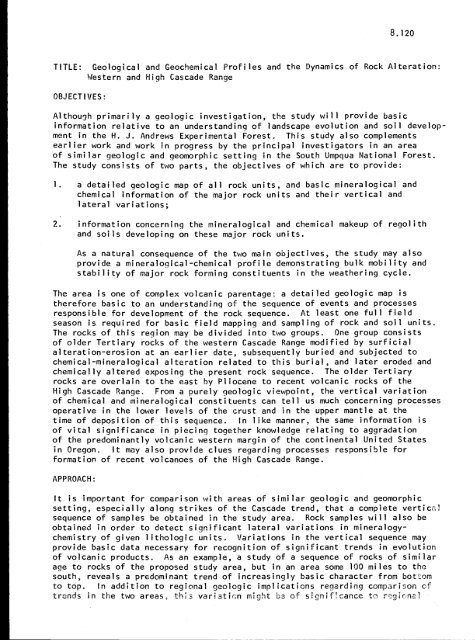FOREST BIOME - ScholarsArchive at Oregon State University
FOREST BIOME - ScholarsArchive at Oregon State University
FOREST BIOME - ScholarsArchive at Oregon State University
Create successful ePaper yourself
Turn your PDF publications into a flip-book with our unique Google optimized e-Paper software.
8.120<br />
TITLE: Geological and Geochemical Profiles and the Dynamics of Rock Alter<strong>at</strong>ion.:<br />
Western and High Cascade Range<br />
OBJECTIVES:<br />
Although primarily a geologic investig<strong>at</strong>ion, the study will provide basic<br />
inform<strong>at</strong>ion rel<strong>at</strong>ive to an understanding of landscape evolution and soil development<br />
in the H. J. Andrews Experimental Forest. This study also complements<br />
earlier work and work in progress by the principal investig<strong>at</strong>ors in an area<br />
of similar geologic and geomorphic setting in the South Umpqua N<strong>at</strong>ional Forest.<br />
The study consists of two parts, the objectives of which are to provide:<br />
1. a detailed geologic map of all rock units, and basic mineralogical and<br />
chemical inform<strong>at</strong>ion of the major rock units and their vertical and<br />
l<strong>at</strong>eral vari<strong>at</strong>ions;<br />
2. inform<strong>at</strong>ion concerning the mineralogical and chemical makeup of regolith<br />
and soils developing on these major rock units.<br />
As a n<strong>at</strong>ural consequence of the two main objectives, the study may also<br />
provide a mineralogical-chemical profile demonstr<strong>at</strong>ing bulk mobility and<br />
stability of major rock forming constituents in the we<strong>at</strong>hering cycle.<br />
The area is one of complex volcanic parentagez a detailed geologic map is<br />
therefore basic to an understanding of the sequence of events and processes<br />
responsible for development of the rock sequence. At least one full field<br />
season is required for basic field mapping and sampling of rock and soil units.<br />
The rocks of this region may be divided into two groups. One group consists<br />
of older Tertiary rocks of the western Cascade Range modified by surficial<br />
alter<strong>at</strong>ion-erosion <strong>at</strong> an earlier d<strong>at</strong>e, subsequently buried and subjected to<br />
chemical-mineralogical alter<strong>at</strong>ion rel<strong>at</strong>ed to this burial, and l<strong>at</strong>er eroded and<br />
chemically altered exposing the present rock sequence. The older Tertiary<br />
rocks are overlain to the east by Pliocene to recent volcanic rocks of the<br />
High Cascade Range. From a purely geologic viewpoint, the vertical vari<strong>at</strong>ion<br />
of chemical and mineralogical constituents can tell us much concerning processes<br />
oper<strong>at</strong>ive in the lower levels of the crust and in the upper mantle <strong>at</strong> the<br />
time of deposition of this sequence. In like manner, the same inform<strong>at</strong>ion is<br />
of vital significance in piecing together knowledge rel<strong>at</strong>ing to aggrad<strong>at</strong>ion<br />
of the predominantly volcanic western margin of the continental United St<strong>at</strong>es<br />
in <strong>Oregon</strong>. It may also provide clues regarding processes responsible for<br />
form<strong>at</strong>ion of recent volcanoes of the High Cascade Range.<br />
APPROACH:<br />
it is important for comparison with areas of similar geologic and geomorphic<br />
setting, especially along strikes of the Cascade trend, th<strong>at</strong> a complete vertic=;1<br />
sequence of samples be obtained in the study area. Rock samples will also be<br />
obtained in order to detect significant l<strong>at</strong>eral vari<strong>at</strong>ions in mineralogychemistry<br />
of given lithologic units. Vari<strong>at</strong>ions in the vertical sequence may<br />
provide basic d<strong>at</strong>a necessary for recognition of significant trends in evolution<br />
of volcanic products. As an example, a study of a sequence of rocks of similar<br />
age to rocks of the proposed study area, but in an area some 100 miles to the<br />
south, reveals a predominant trend of increasingly basic character from bottom<br />
to top. In addition to regional geologic implic<strong>at</strong>ions regarding comparison cf<br />
trends in the two areas, this vari<strong>at</strong>ion might be of significance to regio=nal
















